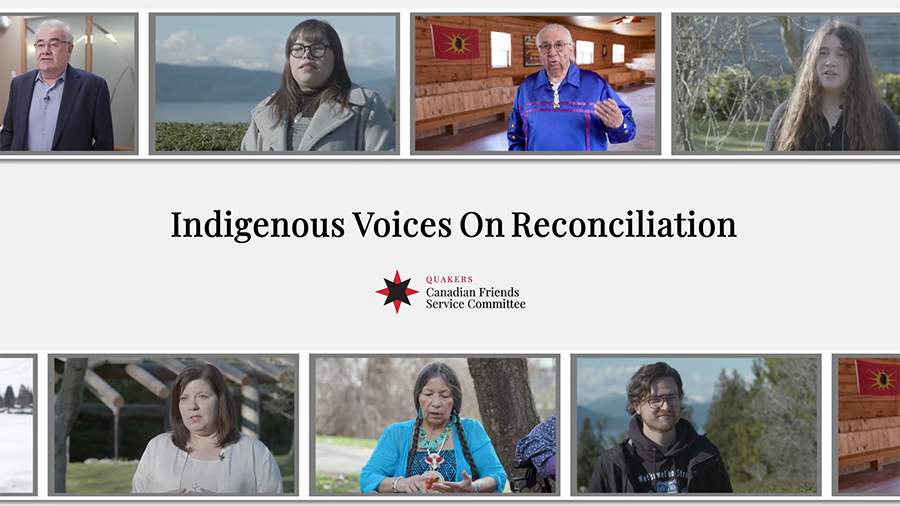Watch accomplished experts offer hope on the path to reconciliation
This past November, I was excited to reconnect with Chief Robert Joseph—a hereditary chief of the Gwawenuk people—at an event for the release of his book, Namwayut. He has been Executive Director of the Indian Residential School Survivors Society and an honorary witness to the Truth and Reconciliation Commission. We first met in 2013 at a two-day workshop for Indigenous two-spirited and non-Indigenous LGBTQ+ people. Later that year I joined some 70,000 people in the Walk for Reconciliation that he led. I’ve also volunteered for his organization, Reconciliation Canada, during the Truth and Reconciliation Event in Vancouver in 2015. Whenever I get the chance to hear him speak or chat with him, I’m encouraged and challenged by his wisdom.
At the book event, he explained that in the Kwak’wala language, the word “namwayut” conveys the deep understanding that we are all one. One common humanity. One connected whole. Chief Joseph has always inspired and motivated me to engage in reconciliation as he did again with this explanation. He also said that reconciliation gave him a gift, and he wants to give his own gift back to the world.
“Reconciliation” is a tricky word. How do we respectfully engage? While the heavy lifting must be done by non- Indigenous Canadians, CFSC knows how challenging this can be. To help, consider checking out a new resource we’ve been working on.
Indigenous Voices on Reconciliation is a series of videos capturing conversations with some of our Indigenous partners. You’ll hear from a variety of different Indigenous people, from youth to elders, with diverse backgrounds as academics, advocates for defending the environment and Indigenous peoples’ human rights, singer/songwriters, cultural workers, and those in leadership roles in their communities. Some are critical about the rhetoric around reconciliation, particularly from governments and others whose actions (or inaction) fails to match their words. Among the speakers in the video series are:
- Naomi Bob, Snaw’naw’as/Nanoose First Nation, Lyackson First Nation, Peguis First Nation;
- Haana Edenshaw, Tsiits Git’anee clan of Haida Gwaii;
- Sheryl Lightfoot, Anishinaabe from the Lake Superior band of Ojibwe;
- Kirby Muldoe, Tsimsian and Gitxsan Nations;
- Collin Orchyk, Treaty 1, Peguis First Nation;
- Katsi’tsakwas Ellen Gabriel, Mohawk from Kanehsatà:ke Nation;
- Kenneth Deer, Bear Clan of the Mohawk Nation of the Kahnawake territory;
- Mary Lou and Dan Smoke, Ojibway Nation, from Batchawana, on Lake Superior, and Seneca Nation from the Six Nations Grand River Territory, respectively; and
- Bill Namagoose, Waskaganish Cree First Nation.
Each of these speakers addresses what reconciliation means to them personally. By considering each perspective, we can begin to understand the complexity of reconciliation. These videos are an excellent reminder to resist easy answers.
“We are all one. One common humanity. One connected whole.”
Some other topics covered include the importance and challenge of land acknowledgements, what it means for a non-Indigenous person to be an “ally,” and what Canada should be focused on.
I love the perspective each speaker brings to the conversation. I found the response to the question on how a non-Indigenous person can be a good ally particularly helpful. As Mary-Lou Smoke says, “many people are sincere in their hearts and don’t know what to do.” Here are some suggestions covered by different speakers:
- Show up and listen;
- Learn about the history of colonialism and genocide, marginalization, residential schools, the reserve system, and the Indian Act;
- Learn about the people whose territory you occupy, who they are, their customs, and their laws;
- Acknowledge your privilege and power;
- Celebrate and mourn with Indigenous peoples, joining in gatherings, marches, and ceremonies when invited;
- Combat the racism Indigenous peoples face; and
- Reach out and form relationships.
Acknowledging your privilege and power can be done positively in a number of ways and should not be viewed as appeasing your feelings of guilt. The next time you’re considering an investment, donation, or how to vote, take the time to think about how it may impact Indigenous peoples. Combating racism can be as simple as saying something. If someone expresses negative views about Indigenous peoples, take the time to talk with them and show them one of these videos. This is also an effective use of your privilege and power.
Each video is brief, most only a couple of minutes. They can be watched all at once or as stand-alone clips, individually or shared with a group. They’re useful in a variety of contexts. For example, CFSC staff member Jeremy Vander Hoek and I included several of them in our presentation Discerning and Engaging with Meaningful Land Acknowledgements at a Canadian Yearly Meeting session in 2022 and later to Quaker meetings in Vancouver and Toronto. The clips helped us elaborate on and emphasize different points in the presentation.
I hope these videos will give insights and motivation to non-Indigenous Canadians to find openings for how they can engage in the hard but necessary work of reconciliation. After your first watch, consider where you might share them! https://QuakerService.ca/IndigenousVoices
Rob Hughes, Vancouver Meeting, lives in the territory of the Qayqayt First Nation in New Westminster. He is clerk of CFSC’s Indigenous rights program committee.
